Quiver Update 2018
 Sunday, November 4, 2018 at 04:44PM
Sunday, November 4, 2018 at 04:44PM 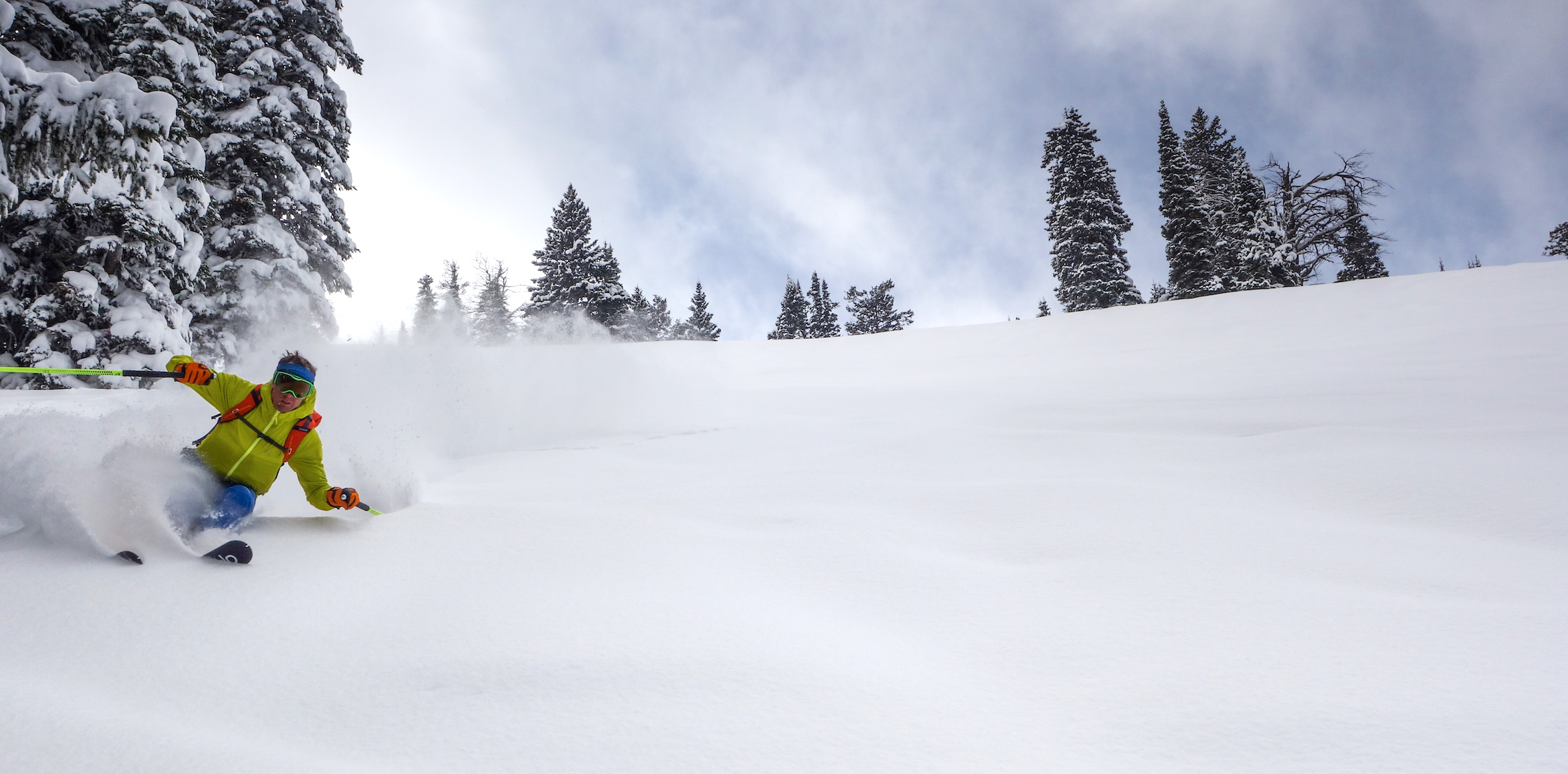 Over the last several months, a few commenters have suggested that I update my “quiver” piece that I wrote several years ago. I’ve certainly gone through a few skis since then, discarding some I didn’t like while embracing a few that I did. I will list my favorites here while expanding on the topic of what (I think) makes a good ski for ski alpinism and general back country whoring. So, while the snow is finally falling in Alaska and the temperatures drop, I’ll take a break from whining about my jacked up knee and write about something perhaps more interesting.
Over the last several months, a few commenters have suggested that I update my “quiver” piece that I wrote several years ago. I’ve certainly gone through a few skis since then, discarding some I didn’t like while embracing a few that I did. I will list my favorites here while expanding on the topic of what (I think) makes a good ski for ski alpinism and general back country whoring. So, while the snow is finally falling in Alaska and the temperatures drop, I’ll take a break from whining about my jacked up knee and write about something perhaps more interesting.
For light-ish and fast-ish ski mountaineering, the choice for skiers has grown exponentially since my first serious forays into the discipline over a 15 years ago. I throw on the “ish” there because I’ve decided that the absolute lightest skis are not necessarily the best tools for what I like to do. Certainly, there are sub disciplines of our favorite activity (long traverses and “tours in a day”) that benefit from, say, race gear but our bread and butter days are better served with more substantial sticks.
There are two reasons I’ve beefed up my quiver. One is that slightly heavier skis simply ski better. Damper, more predictable, forgiving are all qualifiers that come to mind when skis get a little more material in them. This “material” can be a combination of edge thickness, side wall, lay up, core and base. As manufacturers strive to drop weight, all of these qualities are on the design chopping block. Which one(s) are chosen to modify will ultimately impact some aspect of performance and durability.
That brings me to the second point - durability. Whether you’re looking to invest in skis that will serve you well for several seasons or simply want a pair that will get you through your next adventure, durability is paramount. As Doug Coombs once pointed out, you’re gonna hit rocks because that’s where the best skiing is. For sure, while meadow skipping mindless powder is all fun and dandy, my heart lies with the rock-walled, narrow hallways that are the main stay of ski alpinism. Climbing them, looking down them and dropping into them gets my heart racing like no other activity I know. It’s like a drug. The problem is that these ski lines force you to ski only one narrow corridor of glorious snow and that surface and sub surface is often laden with sharks. The right ski will take a hit from one of these predators and hardly show it while others will completely explode and alter the course of your day in a bad way. We’ll touch on both of these scenarios coming up.
Weight Rules
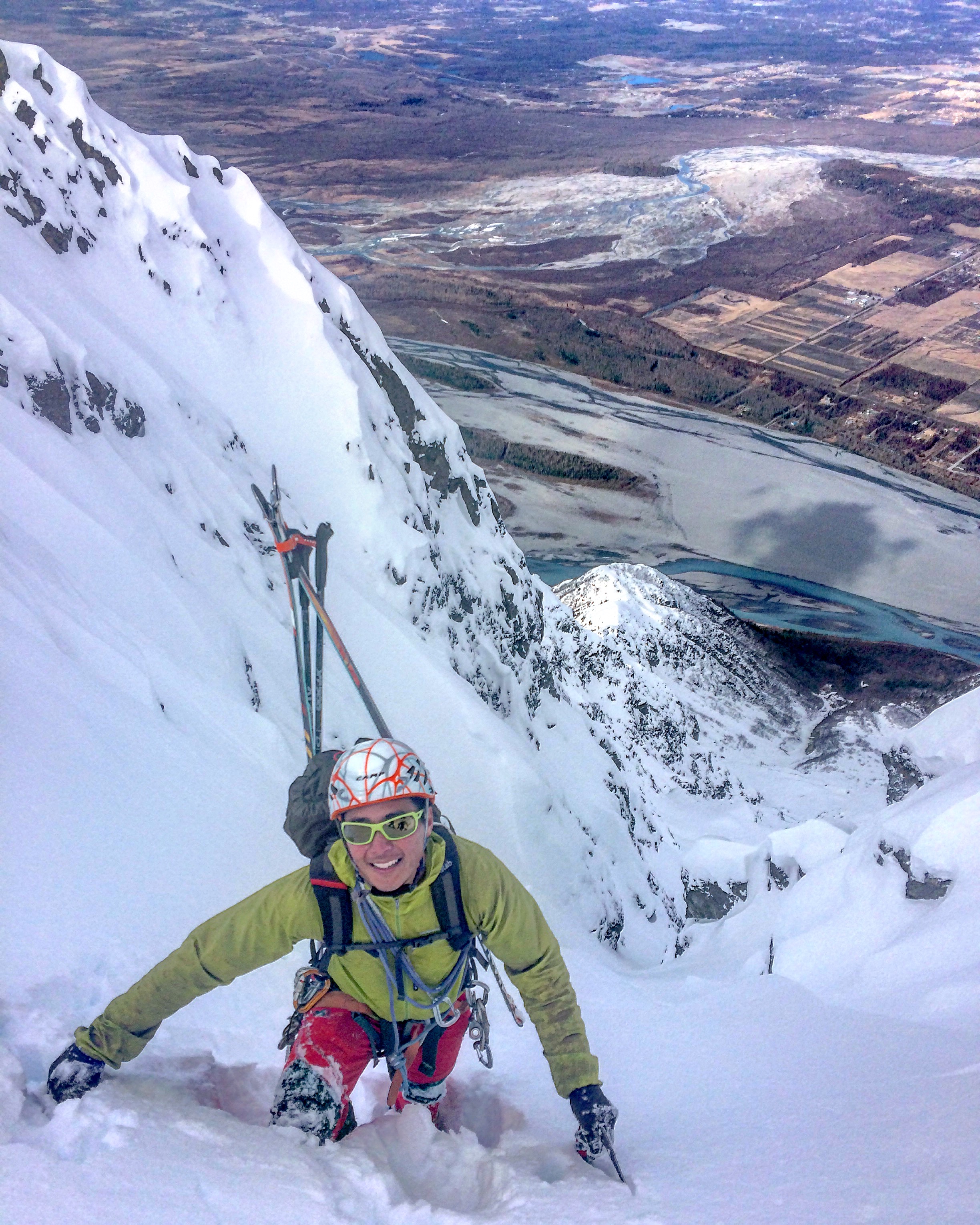 Sam Inouye 6,000 feet above the Knik, appreciating his light set up. Photo: Mat BruntonBack when I was an avid skimo racer, I could literally ski any terrain on any gear. Racing a lot simply makes one capable on a variety of skis and boots. Because of this, I was less concerned about performance of skis than I was about their weight. I wanted to go far and fast (on the up, at least) and every gram counted. I chose skis on that quality alone. And as these tools failed in one way or another, I became aware of how ski designers shaved weight to fill this niche in the market. Performance changes paralleled the weight savings but I didn’t concern myself with that initially. What I did notice, however, was a trend toward several design features that got skis where they wanted them on the scale.
Sam Inouye 6,000 feet above the Knik, appreciating his light set up. Photo: Mat BruntonBack when I was an avid skimo racer, I could literally ski any terrain on any gear. Racing a lot simply makes one capable on a variety of skis and boots. Because of this, I was less concerned about performance of skis than I was about their weight. I wanted to go far and fast (on the up, at least) and every gram counted. I chose skis on that quality alone. And as these tools failed in one way or another, I became aware of how ski designers shaved weight to fill this niche in the market. Performance changes paralleled the weight savings but I didn’t concern myself with that initially. What I did notice, however, was a trend toward several design features that got skis where they wanted them on the scale.
P-Tex
Obviously, most of the time when you hit a rock, the base of your ski takes the brunt of the force. It’s a cringe-worthy moment when you feel that momentary grab and decelleration underfoot. It’s usually followed by an abrupt stop, pop the ski off and check the damage. With the right ski, a smile follows as only a scratch is revealed. On the flip side, your heart sinks as core shot is revealed. Which one you get is in part governed by the both the quality of the base material and it’s thickness and of course, the energy and dynamics of the encounter.
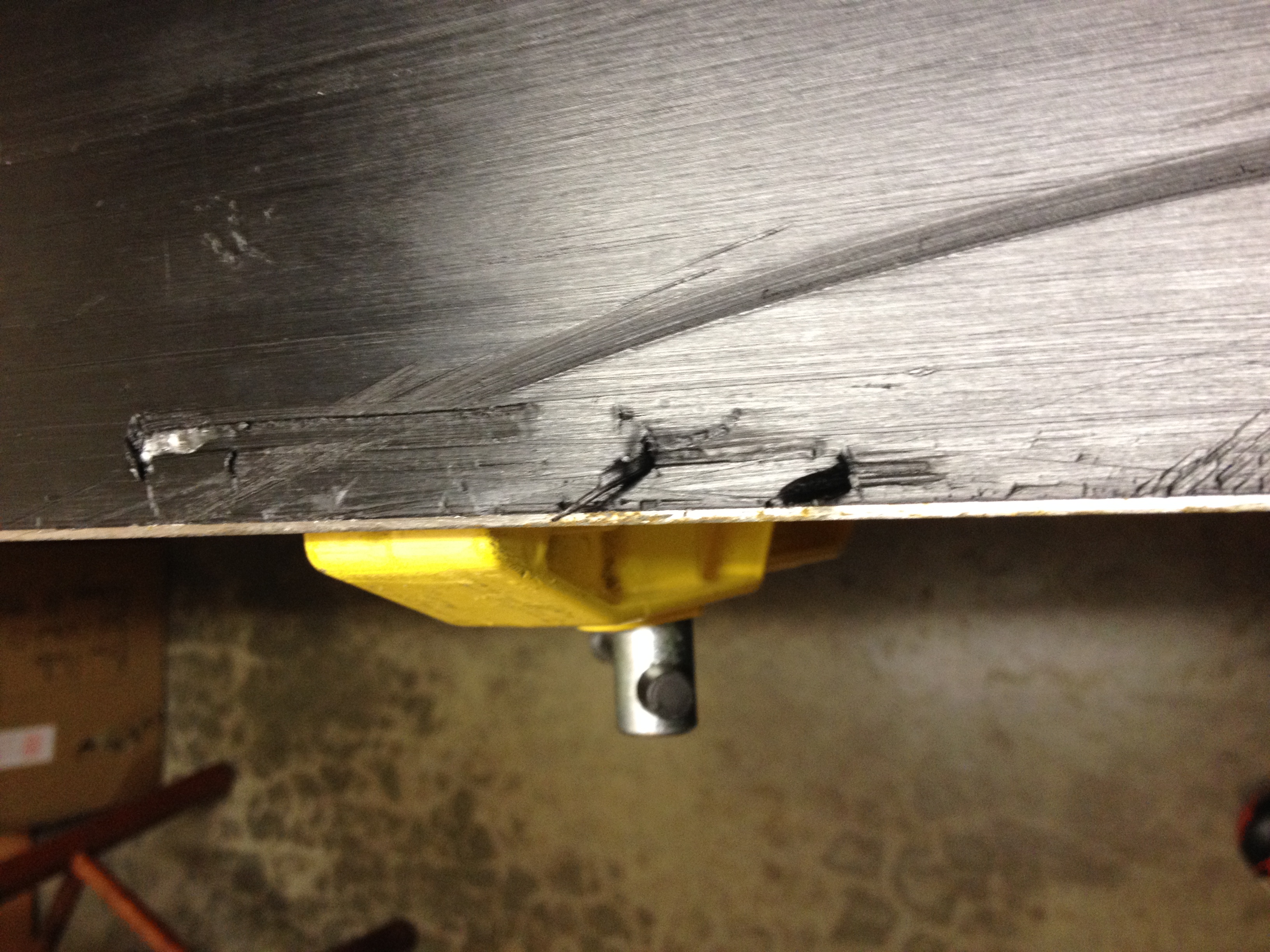 You need enough base thickness to absorb this kind of hitAs you dig down on the base material of various skis, you first notice “extruded” versus “sintered” material. All high quality skis use the much harder sintered high molecular weight polyethylene for their bases. This stuff “holds” more wax and is way more durable than the cheaper extruded crap. Within the sintered genre, you’ll find 2,000 to 6,000 which is a measure of the hardness. Without getting too deep in the weeds, hard base material is more durable but is also harder to work (repairs, filing, waxing). I love spending hours at my ski bench and oddly enough, offer to tune my friends’ skis ….just because. I don’t mind dealing with P-tex 5,000 bases. For the less diligent, the softer stuff will be less frustrating and tedious when you finally get around to some base work.
You need enough base thickness to absorb this kind of hitAs you dig down on the base material of various skis, you first notice “extruded” versus “sintered” material. All high quality skis use the much harder sintered high molecular weight polyethylene for their bases. This stuff “holds” more wax and is way more durable than the cheaper extruded crap. Within the sintered genre, you’ll find 2,000 to 6,000 which is a measure of the hardness. Without getting too deep in the weeds, hard base material is more durable but is also harder to work (repairs, filing, waxing). I love spending hours at my ski bench and oddly enough, offer to tune my friends’ skis ….just because. I don’t mind dealing with P-tex 5,000 bases. For the less diligent, the softer stuff will be less frustrating and tedious when you finally get around to some base work.
Related to the issue of this base plastic is just how thick a sheet they put down. This isn’t always obvious or even stated by the manufacturer. It’s not until you rip your base open that you see just how little there is. To wit, a few years ago I became enamored with Black Crows skis after spending a few months in Chamonix. They were not the lightest skis out there by a long shot but they were sexy. My first early season day saw the mother of all core shots pull out a banana peel section that required field knife application to cut off and make them run again. The shit was like tissue paper. I knew right then how they got the weight down. Other companies have followed suit. You’ve been warned.
Edges
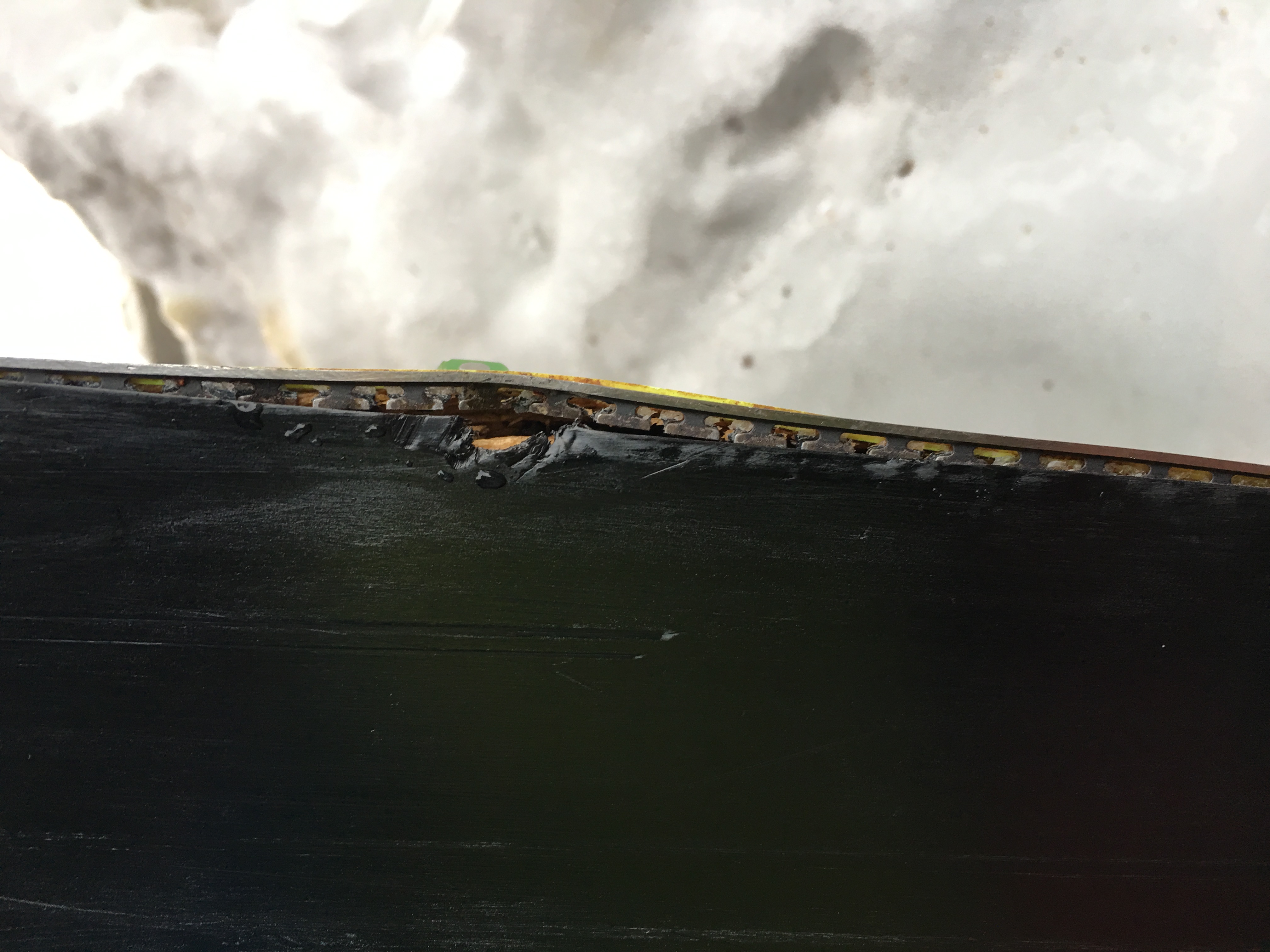 Even a partial sidewall couldn't keep this Dynafit Cho Oyu from explodingMost high end ski makers are using good steel on their edges. To save weight, some skis are built with the edges stopping at the limit of the running surface of the ski. This doesn’t generally cause a problem for normal skiing. However, when negotiating narrow couloirs, ski tips and tails often ride up on the margins. catching the blunt end of the metal edge where it terminates can lead to issues of pulling off away from the sidewall or base. On the other hand, the softer base and glass material seems to catch less when on rock which might be beneficial and is certainly less cringe inducing.
Even a partial sidewall couldn't keep this Dynafit Cho Oyu from explodingMost high end ski makers are using good steel on their edges. To save weight, some skis are built with the edges stopping at the limit of the running surface of the ski. This doesn’t generally cause a problem for normal skiing. However, when negotiating narrow couloirs, ski tips and tails often ride up on the margins. catching the blunt end of the metal edge where it terminates can lead to issues of pulling off away from the sidewall or base. On the other hand, the softer base and glass material seems to catch less when on rock which might be beneficial and is certainly less cringe inducing.
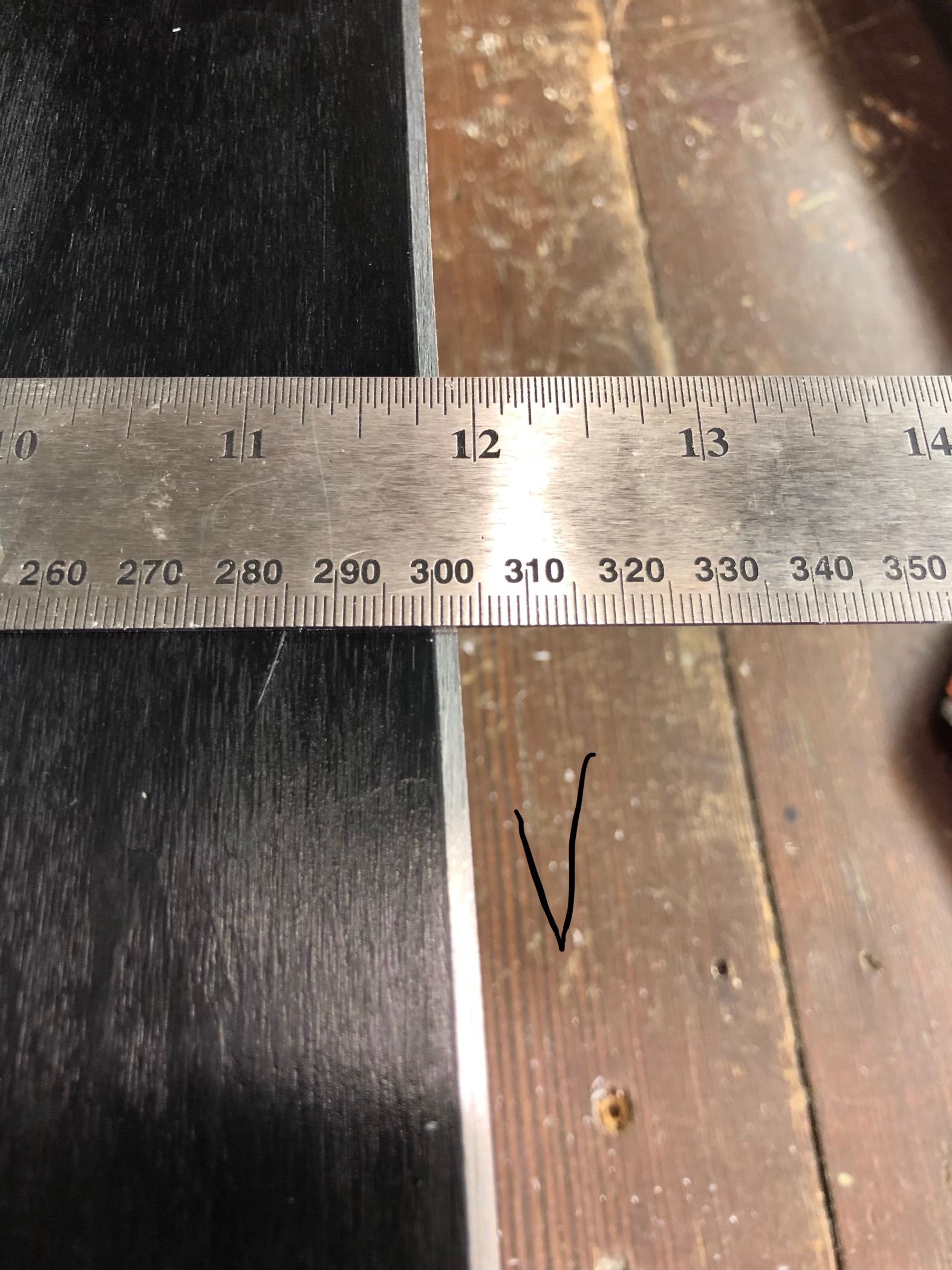 No skimping on steel in the Voile Objective
No skimping on steel in the Voile Objective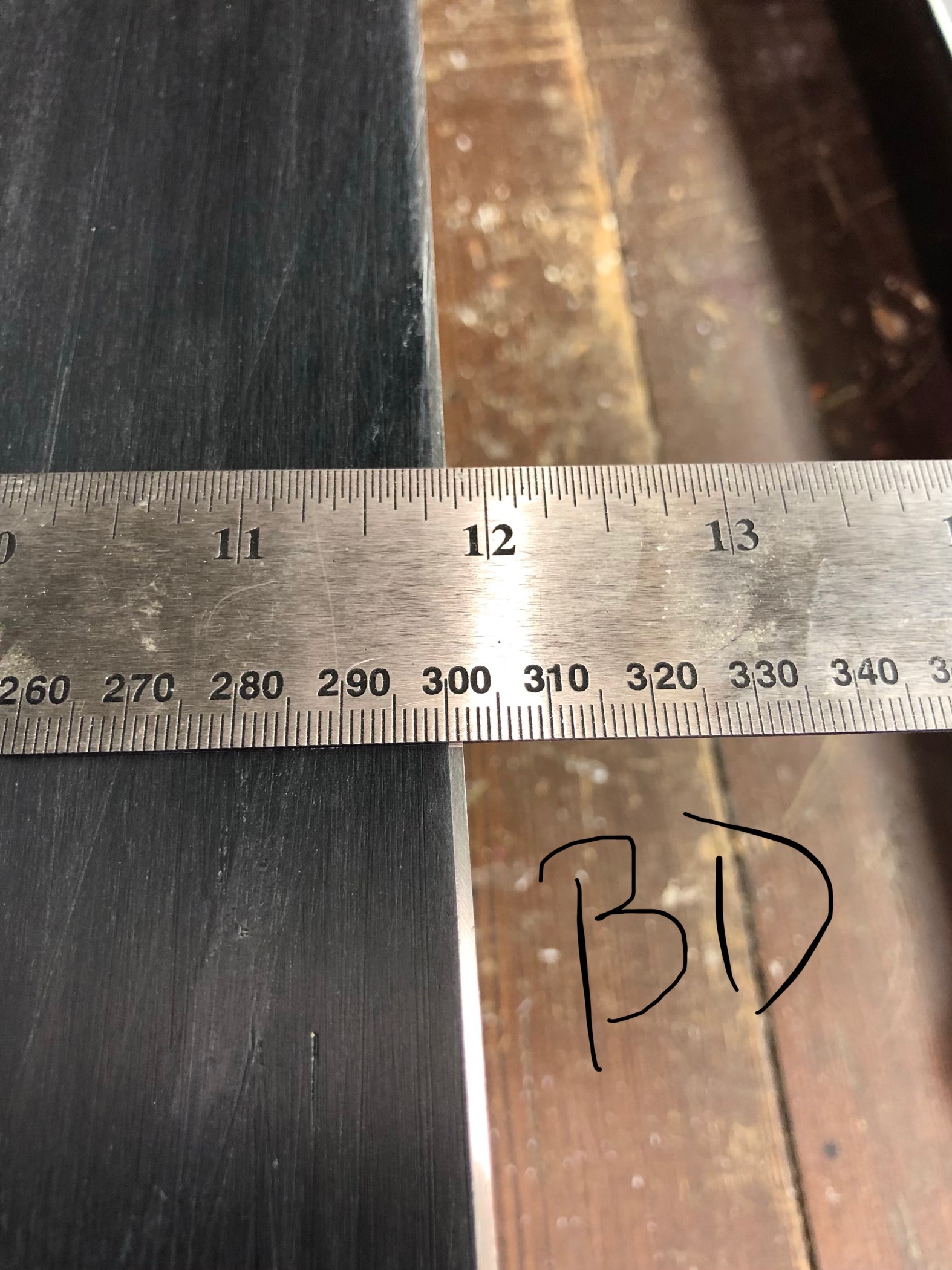 Less metal helps shed some grams on the Black Diamond Helio 95In another weight stripping tactic, thickness of edge material is adjusted. As you can see in the photos, this varies quite a bit. I love thick edges. They last through more tunes (I sharpen my edges often) and take the heat of a rock strike without blinking. Before you fall in love with that sexy new (and light) couloir slayer, take a peek at the edges. If they’re 1mm, put the board down and walk away. Period.
Less metal helps shed some grams on the Black Diamond Helio 95In another weight stripping tactic, thickness of edge material is adjusted. As you can see in the photos, this varies quite a bit. I love thick edges. They last through more tunes (I sharpen my edges often) and take the heat of a rock strike without blinking. Before you fall in love with that sexy new (and light) couloir slayer, take a peek at the edges. If they’re 1mm, put the board down and walk away. Period.
Core
Another key ingredient of a quality ski is the core material. Any combination of fiberglass, foam, wood, rubber and metal can be used and all affect the characteristics of the final product. Obviously, weight is impacted by all the choices but equally importantly, so is the skiability. Qualities like dampness, pop, edge hold, etc, all vary depending upon these choices. I think it’s critical that we find what we like in a ski’s characteristics for the various goals we have and find a few that fill the bill.
Sidewall
Another key characteristic of a ski is the type of sidewall it has. Traditionally, skis all had a standard, full-length ABS plastic sidewall that ran the length of the ski. 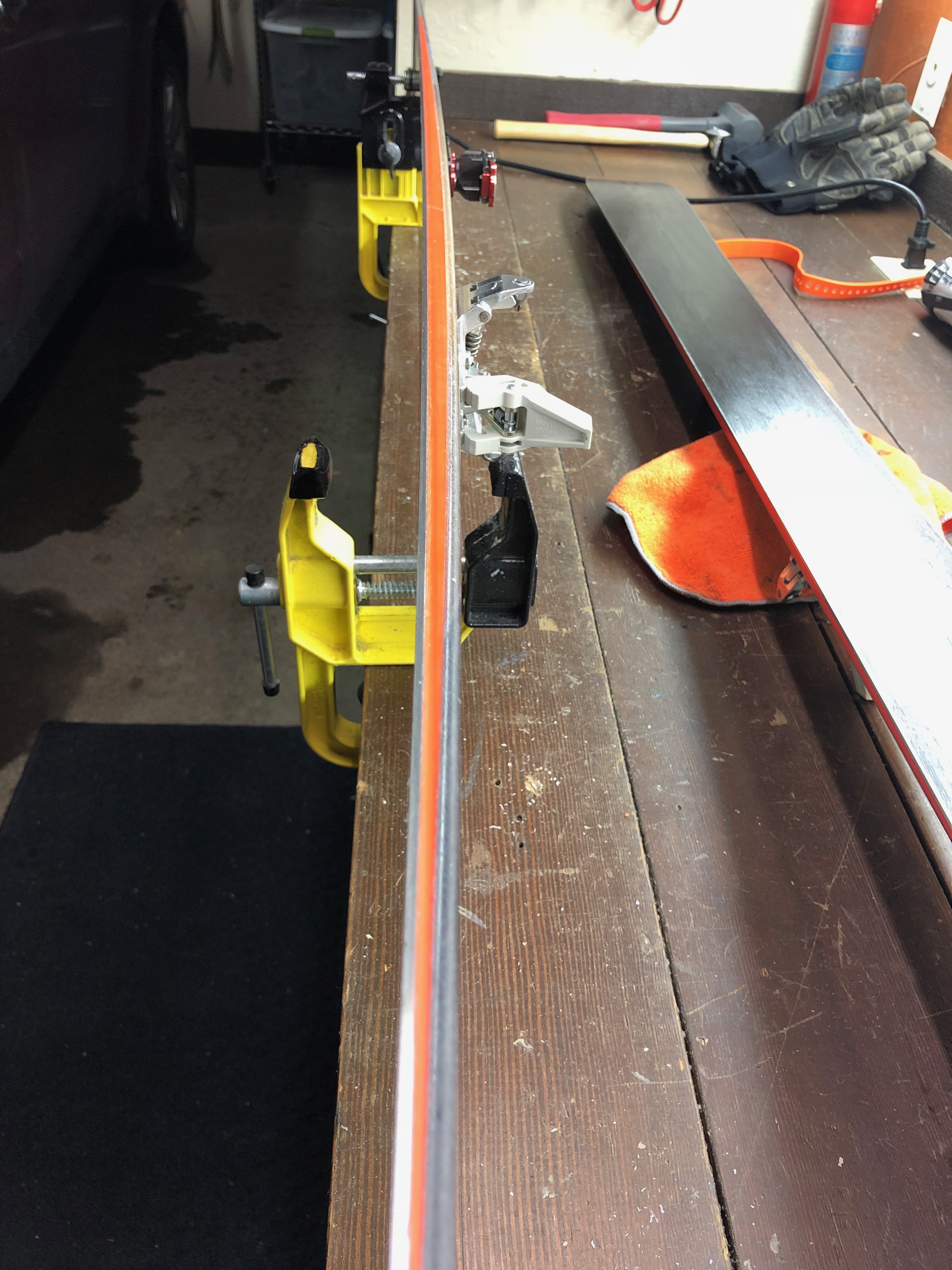 Full length ABS sidewall on the Atomic Backland 95More recently, the development of the cap construction both dropped weight and simplified the lay up of the ski during manufacture. In my experience, cap skis are certainly lighter as a rule but the lack of a real sidewall makes them more prone to rock strike damage to the metal edge. I also find that partial or full sidewall skis tend to have flex characteristics that I favor. There are a lot of subjective terms that go into describing what I’m talking about but I’ll spare you those here. Let’s just say, for technical skiing, I like having at least some sidewall. I say “some” here because several brands have struck a compromise between cap and sidewall construction and have partial sidewalls, mainly under the foot or further fore and aft.
Full length ABS sidewall on the Atomic Backland 95More recently, the development of the cap construction both dropped weight and simplified the lay up of the ski during manufacture. In my experience, cap skis are certainly lighter as a rule but the lack of a real sidewall makes them more prone to rock strike damage to the metal edge. I also find that partial or full sidewall skis tend to have flex characteristics that I favor. There are a lot of subjective terms that go into describing what I’m talking about but I’ll spare you those here. Let’s just say, for technical skiing, I like having at least some sidewall. I say “some” here because several brands have struck a compromise between cap and sidewall construction and have partial sidewalls, mainly under the foot or further fore and aft. 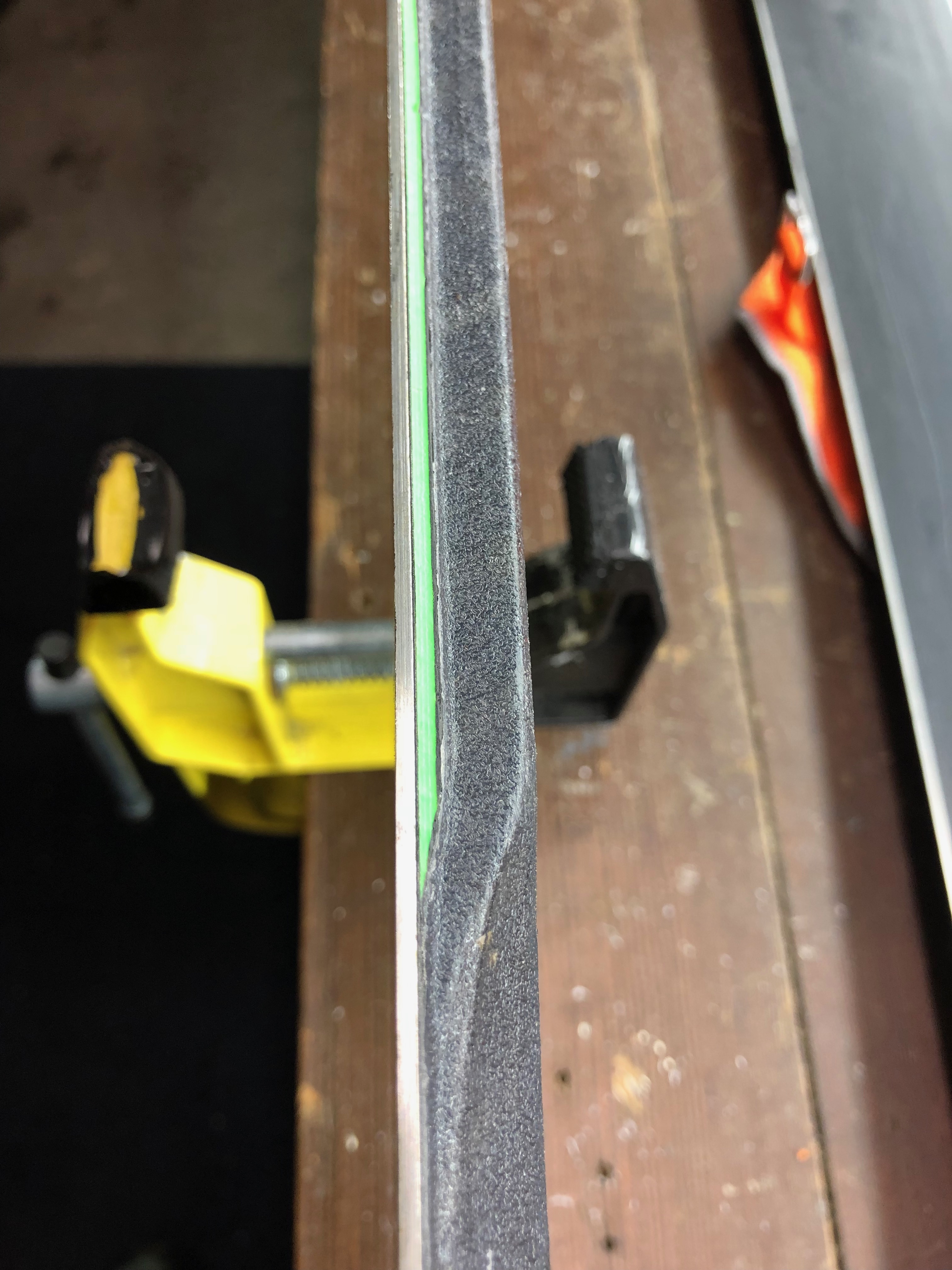 Underfoot ABS sidewall on a Movement Vertex XThis gives some of the benefits of the feature while maintaining some of the weight saving of cap construction. I’ll talk about some below.
Underfoot ABS sidewall on a Movement Vertex XThis gives some of the benefits of the feature while maintaining some of the weight saving of cap construction. I’ll talk about some below.
Glass/Lay up
The final bit of construction minutia involves the outer material of the ski. Once again, I don’t want to get too far into the weeds here. Suffice it to say that you pay a premium for carbon fiber and other more technical lay ups than simple fiberglass. These choices have a significant impact on the durability of the ski as well as turning and edge hold qualities.
Current Quiver
Below are the skis that I have currently in rotation. Although I’m a firm believer in the right tool for the job, I’ve been guilty of taking the wrong ski out for the current conditions because of the nature of the mission. For example, on one blue bird powder day last winter, we were chasing lines that involved a significant approach and ski out. As I dropped into a long bowl run, the 84mm underfoot was not handing the knee deep pow and free ride turns. I adjusted my speed and turn radius and things were fine but a fat ski would’ve been way more fun. On the other hand, the 15+ miles of skinning passed by easily on the more nimble boards. On other days with no particular goal in mind except to just get out and ski, I’ll look at my rack and simply take a pair out because they’ve not seen any action for a few weeks. I’m a firm believer that this kind of variation in both boot and ski choice makes me a more versatile skier and keeps entertainment level high.
Ski Trab
 Although race skis don’t see much use for me these days, I still get out on them for entertainment and a couple of times most seasons they will find their way on some beat down link up/tour that needs speed over all things. The top of the heap in race skis continues to be the Trab Gara Aero World Cup. As much as I coveted this new iteration, I couldn’t justify the $1,000 price tag (yes, really). But when a friend was offering a pair still in plastic for $300, I jumped right on up and took them home. They’re still the best skiing, most dependable race stick on the market.
Although race skis don’t see much use for me these days, I still get out on them for entertainment and a couple of times most seasons they will find their way on some beat down link up/tour that needs speed over all things. The top of the heap in race skis continues to be the Trab Gara Aero World Cup. As much as I coveted this new iteration, I couldn’t justify the $1,000 price tag (yes, really). But when a friend was offering a pair still in plastic for $300, I jumped right on up and took them home. They’re still the best skiing, most dependable race stick on the market.
Movement
If I ever had to commit to one ski brand for all my needs it would probably be this Swiss company. They’ve been making light, durable boards for years. They have a huge following in Europe and only recently traversed the Atlantic to find a steadily growing following here in the States. The reason is simple. They make a wide variety of incredibly durable, light, fun skiing planks. What more do you want? Until recently, their offerings were in the “Euro sizes”, commonly 75mm to 90mm underfoot. But to quench the thirst of fatter ski lovers, they’ve expanded their size range out to 106mm. That’ll handle most pow pow days unless you’re snorkeling in Japan.
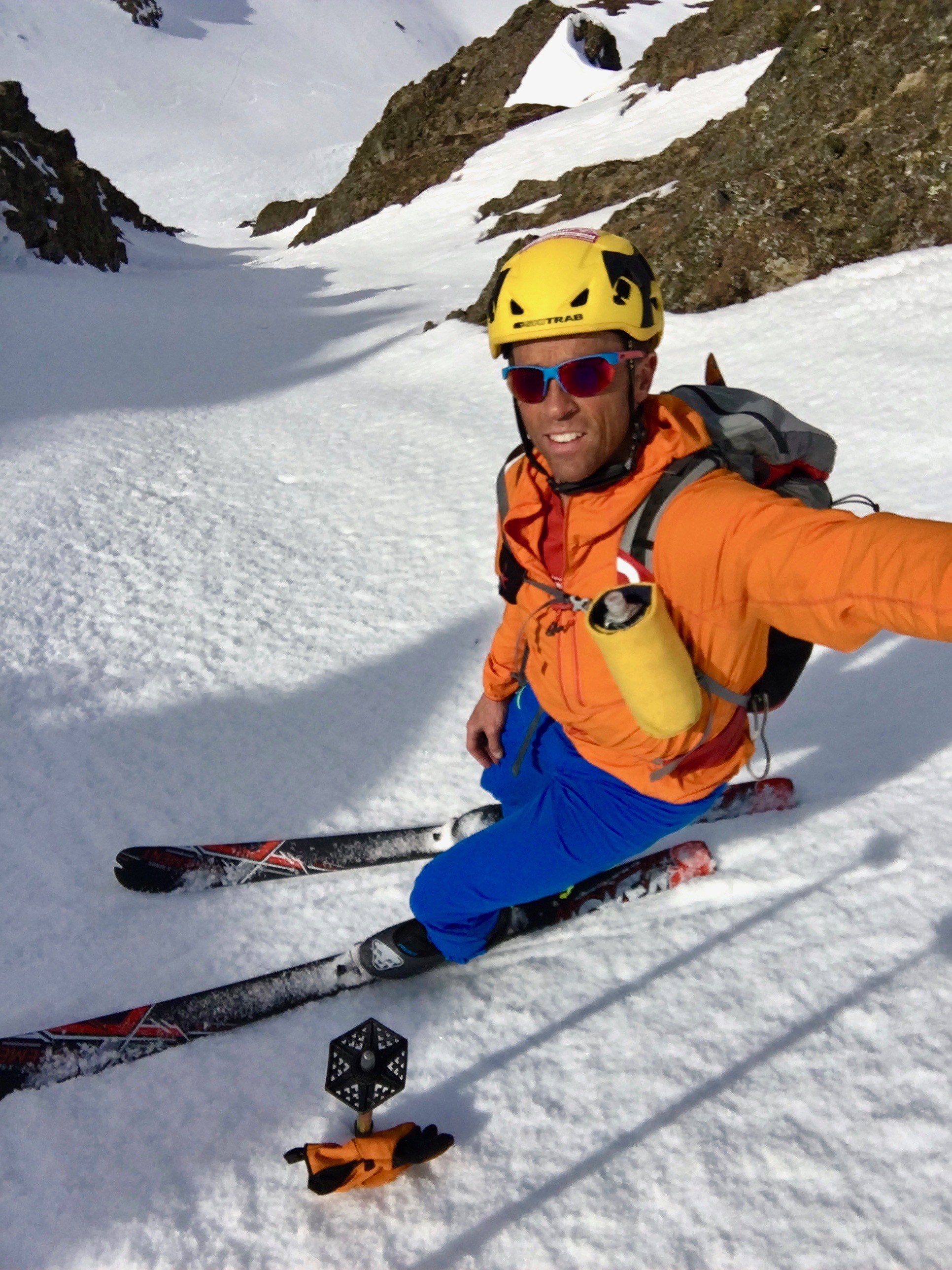 The Movement Big Fish in its elementStarting on the skinny side, my first ski in this line is the Big Fish-X at 77mm underfoot and 940 grams each for the 168cm length with cap construction. This is the least forgiving of all Movement skis I’ve been on. It’s stiff and light and, for me, occupies a very narrow place in my quiver. The ski comes equipped with burly 1.8mm edges and P-tex 5000 bases. It’s absolutely bomb proof on firm, edgy snow in fall-you-die terrain. But I think that’s where it ends. When conditions soften or become variable, the Big Fish tends to beat me up. But I have others in line for that.
The Movement Big Fish in its elementStarting on the skinny side, my first ski in this line is the Big Fish-X at 77mm underfoot and 940 grams each for the 168cm length with cap construction. This is the least forgiving of all Movement skis I’ve been on. It’s stiff and light and, for me, occupies a very narrow place in my quiver. The ski comes equipped with burly 1.8mm edges and P-tex 5000 bases. It’s absolutely bomb proof on firm, edgy snow in fall-you-die terrain. But I think that’s where it ends. When conditions soften or become variable, the Big Fish tends to beat me up. But I have others in line for that.
 Next up is likely my favorite ski for everything - the Vertex X. At 84mm underfoot and 1,100 grams for the 177cm version, this ski seems to do everything pretty damn well. From steep turns on scary hard surfaces to shrelping free ride arcs in boot deep fluff, the Vertex is up to the task. Like I indicated earlier, I definitely want more ski when the bottom falls out but for everything else, this thing delivers. In an interesting move, Movement discontinued this world wide favorite, consolidating it within the Alp Tracks line. The shape remains the same but the new lay up lightens things a bit (1,050 grams for 177cm) and probably changes the on-snow feel but I don’t know if this is a bad thing. Along with this width, they’ve added a 94, 100 and 106mm length if you’re really prone to dialing in your ski choice for the day. I owned the 100mm version for a time but mounted it with a binding I hated due to it’s steep ramp angle. Rather than redrill it I decided to simply sell it. I had no complaints regarding how it skied as it floated well in deeper snow but held an edge like a boss on groomers.
Next up is likely my favorite ski for everything - the Vertex X. At 84mm underfoot and 1,100 grams for the 177cm version, this ski seems to do everything pretty damn well. From steep turns on scary hard surfaces to shrelping free ride arcs in boot deep fluff, the Vertex is up to the task. Like I indicated earlier, I definitely want more ski when the bottom falls out but for everything else, this thing delivers. In an interesting move, Movement discontinued this world wide favorite, consolidating it within the Alp Tracks line. The shape remains the same but the new lay up lightens things a bit (1,050 grams for 177cm) and probably changes the on-snow feel but I don’t know if this is a bad thing. Along with this width, they’ve added a 94, 100 and 106mm length if you’re really prone to dialing in your ski choice for the day. I owned the 100mm version for a time but mounted it with a binding I hated due to it’s steep ramp angle. Rather than redrill it I decided to simply sell it. I had no complaints regarding how it skied as it floated well in deeper snow but held an edge like a boss on groomers.
Voile
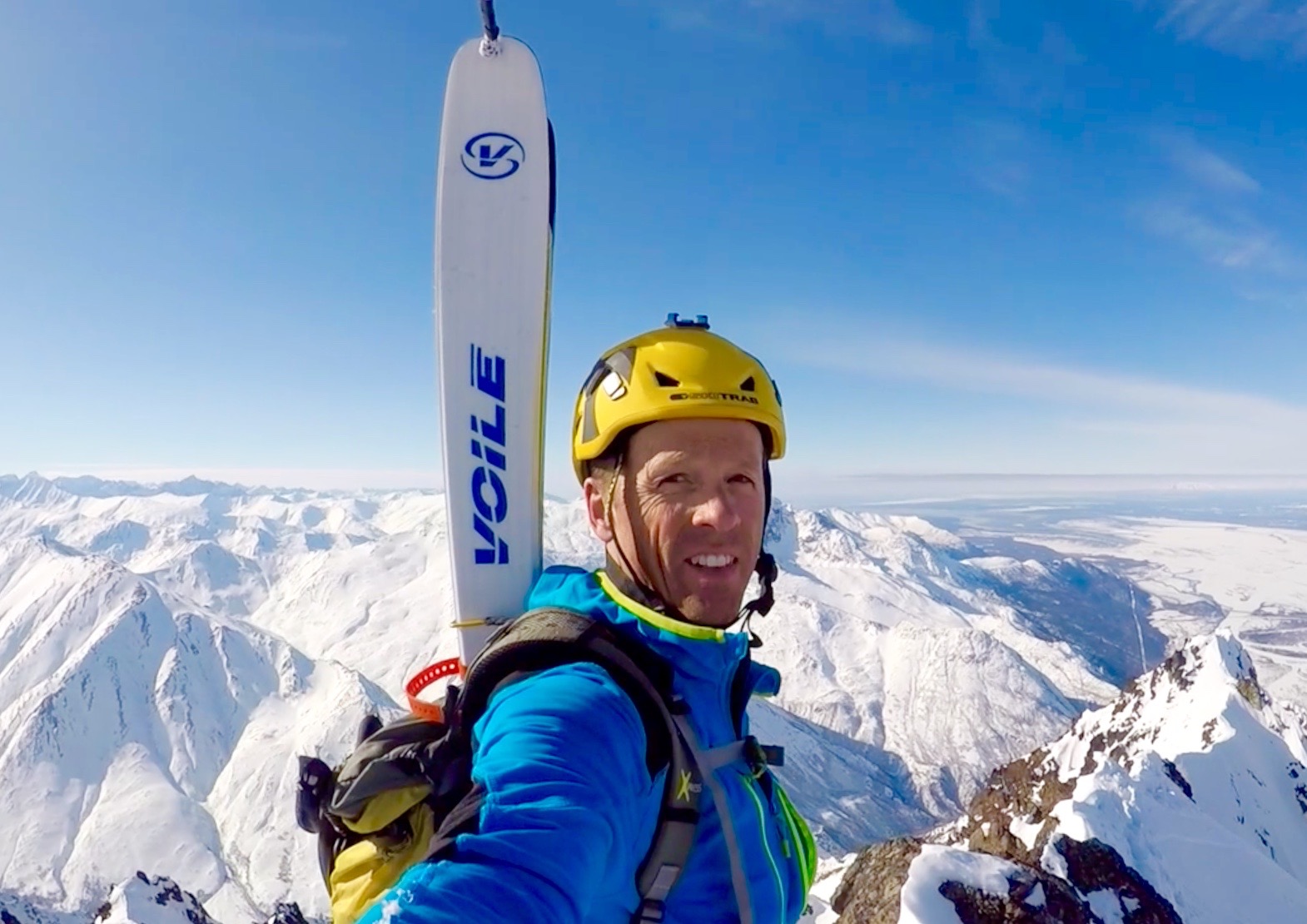 Living up to its name on Pioneer Peak, AKAlthough I love the Vertex X for most skimo outings, I also like a short ski when things get technical and hard in the spring. I could’ve simply purchased a shorter version but instead decided to get something different…just because. After asking around folks who know, the consensus was the Objective by the Salt Lake City based company Voile. I was pleasantly surprised by the versatility of this offering. Like the Vertex, it does everything well. Equipped with beefy edges that can take a hit and a flex pattern that provides predictable turning, this is a ski alpinism tool. The 82mm underfoot and 171cm length comes in a 1,150 grams. I mounted it specifically with the Plum Race 145 fitted for the Scarpa Alien RS. But then I decided I wanted to be able to ski it with a bigger boot and went back and mounted a Race 170 heel on it using inserts for all the holes to maintain my options. It’s the best of both worlds.
Living up to its name on Pioneer Peak, AKAlthough I love the Vertex X for most skimo outings, I also like a short ski when things get technical and hard in the spring. I could’ve simply purchased a shorter version but instead decided to get something different…just because. After asking around folks who know, the consensus was the Objective by the Salt Lake City based company Voile. I was pleasantly surprised by the versatility of this offering. Like the Vertex, it does everything well. Equipped with beefy edges that can take a hit and a flex pattern that provides predictable turning, this is a ski alpinism tool. The 82mm underfoot and 171cm length comes in a 1,150 grams. I mounted it specifically with the Plum Race 145 fitted for the Scarpa Alien RS. But then I decided I wanted to be able to ski it with a bigger boot and went back and mounted a Race 170 heel on it using inserts for all the holes to maintain my options. It’s the best of both worlds.
I’ve had the ski out in everything from frozen-terror-slide-for-life to pretty damn steep and deep pow in the Wasteland. The softer flex and rockered tip make it fun it all conditions. My only complaint is that it’s a full cap ski. The saving grace here is that Voile doesn’t skimp on edge or base material so the fragile nature of some cap skis is avoided here. Kudos to them.
Atomic
 In my desire to move slightly away from bouncy light skis last year in search of a damp daily driver, I settled on the Atomic Backland 95 in a 177cm length (1,350 grams). Obviously, the weight puts in the middle of similar skis in the class. Another couple of options I toyed with that partners like quite a bit are the Black Diamond Helio 95 (1,380 grams for 173cm) and the Movement Apex (1,485 grams for 177cm).
In my desire to move slightly away from bouncy light skis last year in search of a damp daily driver, I settled on the Atomic Backland 95 in a 177cm length (1,350 grams). Obviously, the weight puts in the middle of similar skis in the class. Another couple of options I toyed with that partners like quite a bit are the Black Diamond Helio 95 (1,380 grams for 173cm) and the Movement Apex (1,485 grams for 177cm).
The Backland has full ABS sidewalls and at interesting beveled tip design that makes for predictable and undemanding turning. The tail is softer and more forgiving than more challenging skis in the category (think Blizzard Zero G). Once again, I’ve skied it in all conditions save for pure spring missions since I blew my knee before I had the chance. But for midwinter long-range and short-range outings, the Backland 95 was up for everything.
DPS
 In my opinion, DPS pretty much rules the powder skiing world. My first time on the early generation Wailer 112 was a complete mind-blowing game changer. I’ve been loyal to them for my powder whoring needs ever since. A couple of years ago I updated my choice with the new Tour 1 lay up which cleaved serious weight off the original. That diet comes at the expense of some high speed stability but more than makes up for it on the climb. They switched from sidewall construction to cap build but rocks shouldn’t be an issue when these puppies see the light of day on my feet. I think that the Tour 1 Wailer 112 is the perfect choice for powder shredding in a weight conscious world.
In my opinion, DPS pretty much rules the powder skiing world. My first time on the early generation Wailer 112 was a complete mind-blowing game changer. I’ve been loyal to them for my powder whoring needs ever since. A couple of years ago I updated my choice with the new Tour 1 lay up which cleaved serious weight off the original. That diet comes at the expense of some high speed stability but more than makes up for it on the climb. They switched from sidewall construction to cap build but rocks shouldn’t be an issue when these puppies see the light of day on my feet. I think that the Tour 1 Wailer 112 is the perfect choice for powder shredding in a weight conscious world.
So, that pretty much rounds out what skis I’ve been on lately. These are the keepers. You'll find everything here, expert advise and top notch customer service at Skimo Co in Salt Lake City, UT. Truly one stop shopping for all your ski mountaineering and free ride/powder shredding needs.
 Brian |
Brian |  26 Comments |
26 Comments |  Skimo Co,
Skimo Co,  ski mountaineering,
ski mountaineering,  ski tourning in
ski tourning in  Gear
Gear 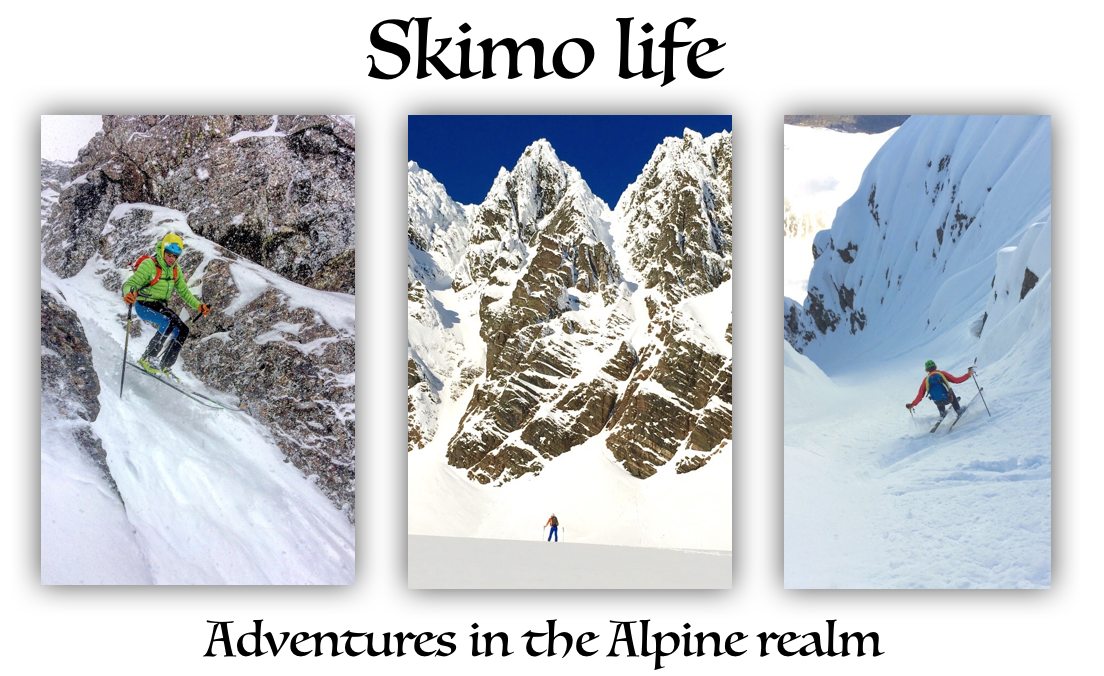



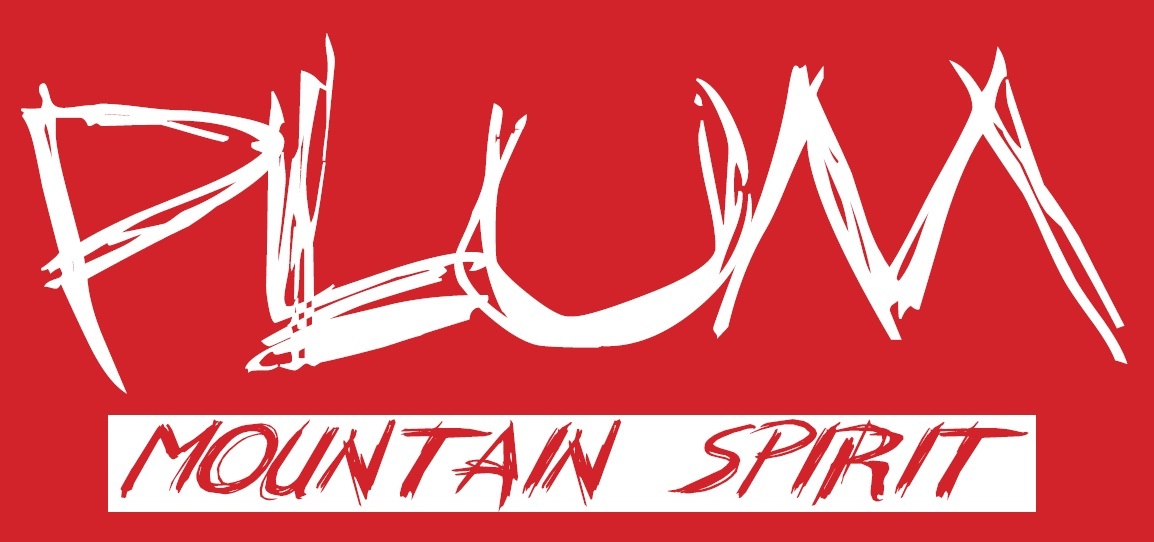
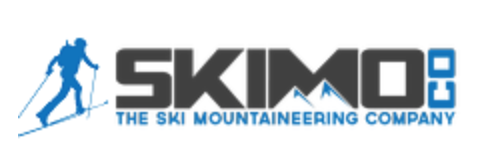
Reader Comments (26)
Brian, psyched to find you blogging again. Glad you took the recommendations of the commentariat -- this post is a gem. As usual, you've got the depth of knowledge, the experience in steep terrain, and the geeked-out technical side of rando gear as well. Cap vs sidewall, edge thickness, and base hardness are all legit concerns with lightweight skis, albeit you can get the bulk of that stuff in the specs on Skimo Co. What you can't get quite as much from the 'net or the local BC ski shop is that sense of what the core and layup make the ski "feel" like, and what they do for you... I guess you just gotta buy a bunch of expensive boards and try 'em all!!
I've been super impressed with the Movement line, especially the Alp Tracks 84. I never skied the Vertex or Bond X but the Alp Tracks completely lives up to the "do-everything" hype that you gave it. It might the epitome of what Lou Dawson calls the "classic touring" ski -- it skins fast, kick turns fluidly, can wiggle turns in powder/corn or straightline in crud, or edge hard and traverse cleanly. What is especially impressive to me about the Alp Tracks 84 (since it is dimensionally a "little" mountaineering ski) is that it also goes FAST. The ski frickin' rips, with no apparent speed limit. I'm 6'3", 190lbs and it's been easy to overpower my Voile Objectives, Dynafit 7 Summits, Salomon MTNs and other soft-ish skis. If I could only own one touring ski, the Alp Tracks 84 would be it. I'd be psyched to get the 100/106 if they ever come down from the one grand price point. According to those who know, they're the best-edging powder skis on the market.
Would be interested to hear more perspective on the Backland 95's. Honestly, I was a little surprised to see you on them since they seem like more of a new-school, flexy ski and not a precise Euro-style plank. That said, maybe a midfat ski should be more forgiving than a pure touring build. I've been curious about the Ski Trab Mistico/Maximo since they marry the lightweight 14 layer Trab construction with what is supposed to be extremely impressive downhill performance. My choice in the mid-fat category for the past two seasons was the Cho Oyu, though they proved a little too sidecutty for my weak form. For this year I sprung for a pair of Sportiva Vapor Sveltes as a powder-lapping tool. Not sure if anyone would call it a "surfy" ski, since the Vapor line is all about ultimate weight savings more than flex and feel, but I'm still swinging in the direction of ultimate light weight and the accompanying vert accumulation rather than ski feel. And anyhow, if i'm venturing into steep and rocky terrain, the nod goes to the Alp Tracks or some <80mm plank for hop-turning control.
Let's hear some more about that knee... how long til you get to ski again?! The world misses the Brunton-Harder bromance!
Hey Scott,
Thanks for the thoughtful response and input on the Alp Tracks. I think you'd find the 100mm just as secure but with more lift for deeper snow.
I had the Cho Oyu in 2014 and even brought them to Cham for my stay there. The only time I really liked them was skiing slide for life boiler plate on my first day with them. They definitely held an edge. Like you pointed out, the side cut that helped with that quality also made them a little "swimmy" when the bottom dropped out of the pow. Dropping speed made them manageable but I never embraced them. Once a bubble formed on the base and I warranteed them, I sold the new pair straight away. Mat has had at least a couple of pairs and has not had much luck with them staying together after modest rock strikes. The weight cut comes at a cost.
The Trab skis you mention are likely fine for harder snow as they are quite stiff. But, like the Big Fish, I like something with a little more give.
I've heard the Sportiva Vapor is fun enough but they can fail suddenly and without warning. I've seen them snap and have inserts pull out. Not a lot of material there with the weight so low. But with your MOG status (man of girth), you be a good test dummy for their durability.
I'll throw up an update on the knee and the latest surgery soon. I just wanted to take a break from the medical stuff. Gear is more fun to read about! Hopefully, adventures with my bro will commence after the first of the year.
Man of Girth, ha! We'll see how the Vapor Sveltes work out. I'm a size up from the average ski tourer, true, but I'd like to think I make up for it with conservative (aka slow) skiing. That said, inserts pulling out is a creepy thing since it can happen in wet/heavy snow even if the ski doesn't strike a rock/tree/avy debris. I haven't pulled an insert since my tele days but it might happen this winter. Really, I got the Sveltes because I was tired of skiing rare and precious powder days on my Hagan Cirrus because I was "training" and didn't want a heavier ski to mess up my skinning technique. Pretty silly from one perspective, but it's hard to argue with more runs. Maybe someday I'll wizen up and get some DPS like everyone is doing ;-)
I seem to remember you were on the Volkl VTA's (or maybe the BMT?) during your South America trip a few years back. Are those still in the quiver? I skied a day with a guy who is a "real skier," aka former alpine racer and coach, last spring, and after I told him about my preference for traditional sidecuts and flat tails he pointed me in Volkl's direction. The VTA 88 has gotten some good press from the Euro mags but has been pegged as "hard to ski" by the North American talking heads. To some degree it looks like a bigger Big Fish, so maybe not the soft snow charger than the dimensions would suggest, but at least it's got width on its side in manky conditions.
MOG. I wish I could take credit for it but I have to point to Kevin Mahoney for that one. He's a proud MOG and as you probably know, can seriously pull down, particularly on sketchy ice. Not as commonly known is that he's a ripping skier.
You're right about the Volkls. I have a pair of BMT 95. During that season of skiing them I had no real complaints. I may have even referred to them as a candidate for the single quiver ski. After getting on other boards of similar dimensions since then, however, I've decided that I'm not that fond of the reverse camber they sport. They tend to "swim" around in powder, at least at the tip and the lack of camber makes them really shitty on firm, steep skin tracks. They still see some use early season, however, rock skis and such. I loaned them to Olympic Nordo David Norris who liked them quite a bit. He did some serious shark farming on them and they were up to the abuse in spite of their lean base thickness and skinny metal edges. The partial sidewall construction likely helped as I point out above. Some OCD base welding work corrected the cosmetic problem.
I love the image of you skiing pow on the Cirrus. I've done that. For a skimo racer it's fine. I've never been on the VTA but they're light af for sure. The fact that they're reportedly unforgiving doesn't surprise me. Seems like really light mid fat skis are made stiff almost out of necessity unless you employ some expensive core shenanigans like the Vapor.
Hey. Great overview. No surprise, of course. But, still. High value, high experience-IQ. Thanks.
As you know, I tend to ski gear well past its "best by" date. Heck, I'm still riding those old Dynafit Carbon 10's you set up for me at least a decade ago! Mostly when skiing lift-served with my daughter, but they remain serviceable. And of course, I have the DPS Wailer 99's you scored for me three years ago.
Honestly, while the DPS are decent pow skis, I just don't really "love" them. Something about that big paddle out front that feels slappy as hell when I'm on anything less than smoke or chowder. So, if you were going to buy one more pair - a do-it-all-pretty-damn-well option - what would you buy?
Asking for a friend. Ha.
Matthew
Mate,
It cracks me up that you show up on the blog from time to time. Nice to see you are still paying attention to my infrequent opinionating. Thanks for the support.
Knowing your style and leanings as well as your technical chops, I would steer you to the Movement Apex. Now I say this having never skied it. It's a tad heavier than what I typically go for because of all the reasons I detail in these pages. But as I evolve, my perspective broadens and the Apex is now in my field of vision.
I have a couple of partners who love this ski for high consequence skiing. Their fitness allows them to overcome the extra 200 grams. My sense is that a guy like you will find the additional mass pleasing in all the ways you appreciate about a ski. If I remember correctly, that Dynafit dinosaur you're on is a stiff carbon plank which is likely why you don't mind it on corduroy. I don't think the Apex is a noodle like the Fischer Hannibal, as an example.
The other option in this class that has some buzz from people I respect is the Dynastar Mythic. You can read about both at Skimo Co's website.
Bon appetit!
Gotta chime in to say the fishscale version of the Objective's ("Objective BC") is a total game changer for fast trips/mountaineering/big traverses.
These fish scales have 2x the grip of any other I've used so it's a legitimate option to leave the skins at home. Normally I bring them, but only put them on for big steep climbs. We're you're skiing you can't tell the fish scales are there, and when you're on rolling terrain or moderate ascents they are worlds better than skins. This makes you faster for small climbs and lets you save your skins on multiday trips. Especially primo in the spring when it's warm/mush and snow can glop onto your skins because the fishscales have mega-traction on this snow.
IMO, fish scales are the future for all backcountry skis. I want some on my Lotus 138's everytime I'm floundering across a flat area. Tons to gain and nothing to lose.
Hey Dan,
Thanks for chiming in. You seriously have my attention with your claims. I've been aware of Voile's fish scale boards for a few years as I think the Vector was offered as such back around 2012-13. Having grown up Nordic skiing in the 70's, I've used several different scaled ski models from Fischer, Track and maybe Karhu way back when. More recently I had a pair of Madshus touring skis but they didn't really do anything that well. I'm intrigued by the idea of an Objective that has better performance when it comes to grip and glide. I'm not sure I'm curious enough to shell out the cash to find out but maybe I could get a demo pair to write about?? Stay tuned. Thanks for tip!
I have Karhu Guides as well, and the Objective BC's are world's different in terms of grip because the pattern is much more positive. I could barely ascend a typical logging road approach on the Guide fishscales, but with the Objective BC's I can probably make it up 70% of the skin tracks out there, depending on the slope and snow conditions.
In terms of slope, if an ascent requires the high heel lift position then it won't work, but usually if a skin track works comfortable on medium heel lift then fish scales can probably make it up. For snow conditions, they are noticeably worse than skins in powder but almost as much grip on spring snow/corn.
The real advantage isn't leaving the skins off on long climbs though - little to gain there since skins work well and the time to put them on is minor compared to the time on the ascent. The big advantage is being able to skips the skins on short climbs, low angle climbs and across flat lakes and glaciers. Big time saver on rolling terrain, plus you keep skins fresh, plus kick and glide on flat terrain is so much faster. Makes a big difference on long spring traverses when sloppy conditions can soak skins at lower elevations. Also just handy for not having your skis take off on you when you're trying to step in at the top of a couloir.
So I find the advantages to be substantial and the downsides imperceivable.
More good news there. And I'd think that the addition of a ski crampon would open the options further. In the spring, when it's steep and hard you're likely booting in spikes anyway. Just might jump on this. Thanks again.
This is a superb bit of commentary and analysis, best write up of the plus and minus game of light weight vs durability and dampess that I have seen. I would love to see your take on the same questions regarding boots (currently loving the Alien RS but always seeking high level beta like you provide). I hope your recovery is complete soon. I'm a huge fan of in-depth long form analysis like this and there is very little of it to be found anymore.
Thanks for commenting, Kevin. It's important feedback that keeps me writing, albeit somewhat too infrequently.
Not sure if you saw this but http://www.skimolife.com/journal/2018/2/13/boot-unrest-whats-old-is-new-and-the-scarpa-alien-rs.html covers some details and thoughts about the RS and a few other considerations. It's a tic out-dated now that I'm on the Scarpa F1 this year but you might enjoy some of it.
Great post. Thanks.
Could you give more details about this?
"The final bit of construction minutia involves the outer material of the ski. Once again, I don’t want to get too far into the weeds here. Suffice it to say that you pay a premium for carbon fiber and other more technical lay ups than simple fiberglass. These choices have a significant impact on the durability of the ski as well as turning and edge hold qualities."
I certainly don't have the expertise to detail the various techniques used to build skis. I have enough insight to know that material choice, lay up design and other construction considerations create the final cost of the product. Fiberglass versus carbon, the type/quality of the carbon, sidewall versus cap, prepimpregnated laminates, fully hand laid versus automated, made in China versus Austria, etc. There are numerous reasons why some skis cost $1,000 and others $600.
I'd love your advice on ski length for a spring more technical and harder snow ski. I've never had more than a quiver of one but am considering adding the above ski.
I'm 185lbs dry, 5'10.5 and have always skied ~180 to 185 cm. I'm considering a 86 mm g3 findr (in part due to good price I can get) in either 172 cm or 177 cm. I've never skied such a short ski and am a little hesitant that if I find myself in spring transition snow (not fully corn yet) 172 might be too short.
Hey Aaron,
Thanks for commenting. We're in full spring up here in AK right now. I'm 6' and 175 lbs. This weekend I did 3 x 8k' days on Scarpa Alien RS and Voile Objectives in a 170cm. Great combo. That same ski and bigger boots like my Scarpa F1 and I can ski any spring condition. Take the F1 and use a Movement Vertex in a 177 and spring pow is also on the menu. 84mm underfoot seems to do it all in my hands. For your weight, a little more length won't hurt. Sadly, I know nothing about that ski so I can't make a side to side comparo for you.
The other thing about narrower skis is that they perform so much better when it's either real corn or frozen. So many people head up with fat skis and it's painful to watch. Not only do they unnecessarily burden themselves with the weight but they have to fight the girth when trying to put the ski on edge on hard snow. The width can overpower lighter boots. There's a reason WC slalom skis are narrow.
What a great post...and blog. Thank you!
As Scott suggested last year, highlighting the Atomic Backland 95s seems a bit surprising in the context of the other skis you've selected.
If you don't mind, I'd love to hear you expand a little more on how you feel about them, both in comparison to the other skis and given that roughly half a year has passed since your original post.
They're on my short list of skis to purchase next as an all-around, single ski for moderate touring in the Eastern Sierra.
I'm also keenly interested in the Movement Alp Tracks 94 and possibly 100, but the Atomic may be a more sensible choice.
Hey Pieter,
For some reason, your comment was in a "suspected spam" folder. Sorry for the delay in response.
I really have little negative comment on the Atomic ski. It has proven to be quite capable in all mid-winter steep skiing scenarios. I actually have not had it on super hard snow where I typically prefer the narrower Movement Vertex-X. But I suspect it would be fine there. But I chose it for most winter missions where steep couloirs are on the menu.
The most distinctive feature that separates it from a lot of my other lighter skis is its dampness. So many of the light skis like those I like from Movement get bounced around in variable snow and are chattery on hard snow. No such issue with the Backland. The extra 200 or so grams with more substantial core material and real side wall likely plays a role. They are not as stiff as say a Blizzard Zero G. I'd like to take those out in order to compare. But I generally favor a softer ski with a more forgiving tail flex.
The other ski that meets all these criteria is the Voile Hyper Vector. I love the narrower Objective and I've heard that the Vector is simply a wider version of that. Something to check out.
Thanks for reading.
Hey Brian,
Been glued to your instagram feed with all the spring/summer skiing you've been getting after...looks awesome. Interested to hear details of the PNW trip and AK bike-to-ski days if you get around to blogging. Seems like equipment is the focus on the blog these days but I for one am down to read a good TR (yours always are).
Circling back on gear (skis), however-- Finally ordered a pair of the Alp Tracks 100 this March and damn do they rip. I only got to ski them about 20 days before the season was over but they for sure lived up to the hype. Great powder ski (duh), but also a solid choice in crud/mank/corn/firn/etc. Would still choose the AT84 for steeper terrain and putting them on the pack but for almost all "touring" the 100's crush it. First time I've felt like a ski that big could be a daily choice in a maritime snowpack (though they have to be paired with a race blend mohair skin to go uphill OK). In the end I didn't break the Sveltes, but I found them skittery, uncertain and nervous when turning in anything but the deepest powder. Planning on selling them as they overlap with the AT 100's. Lots of ski-ADD here to be sure!
@ Pieter, who commented above, get some Movements -- you won't be disappointed. Not sure if "moderate touring" for you is more of a powder hunting affair or involves getting up on the 14ers, which might dictate your choice, but the AT 100 would serve well for both if you are a new-schooler who likes having a wide ski under your feet. Maybe the 94 would be the perfect ski as it shares the flat tail with the 84 but has a bit more side cut and rocker. I think Skimo Co has a demo pair on sale right now if you're looking.
Hey Scott,
Thanks for the comment and the kick in the ass for some other writing topics. I have a couple in mind that are not gear centric. And you're right. The unexpected bout of unemployment has created a unique situation where I have time to ski more than usual. And AK's mild spring has delivered more days than average. I have to take a recertification exam in a week but maybe I'll get cranking on something after that.
Glad the Movements delivered. Hard to go wrong.
Cheers.